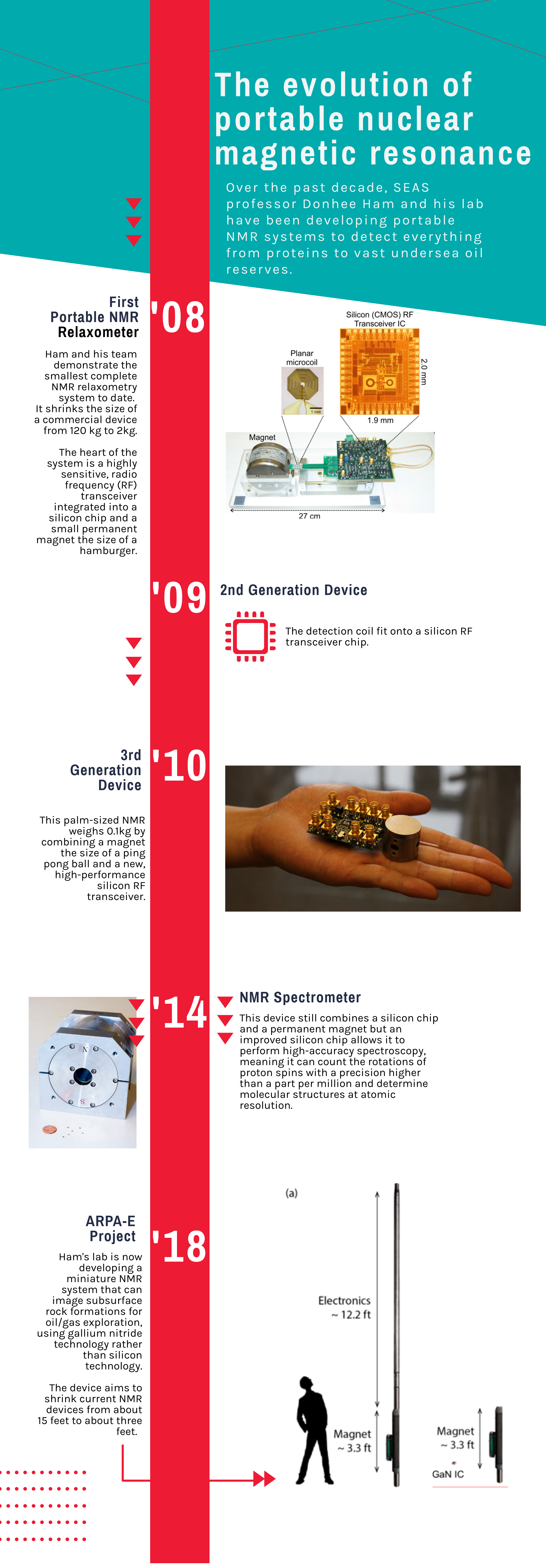News
Donhee Ham, Gordon McKay Professor of Electrical Engineering and Applied Physics, has been awarded $1.7 million from the U.S. Department of Energy’s Advanced Research Projects Agency-Energy (ARPA-E) to develop miniaturized nuclear magnetic resonance (NMR) electronics. The devices’ small size and low cost lend themselves to broad deployment in Earth’s deep subsurface, enabling imaging of rock formations for oil and gas exploration.
NMR is a technique that perturbs protons within a molecule to glean important clues about its structure and motion. It can identify unknown substances, detect very slight variations in chemical composition with atomic resolution, and measure how molecules move and interact, making it an essential tool in organic chemistry, structural biology, and drug discovery.

Since the 1990s, NMR has been a vital tool for petroleum exploration in the oil and gas industry. It is used to examine fluid compositions as well as molecular interactions between rock surfaces and fluids and has helped discover large oil and shale reservoirs in Brazil and the United States.
However, current NMR electronics used in oil and gas discovery are bulky, heavy and expensive. They stand more than 12 feet tall and weigh more than 200 pounds. Ham and his team are looking to change that by integrating the bulky NMR electronics into a semiconductor chip that can be held at the palm of a hand.
“Such small NMR electronics can be far more broadly disseminated throughout geological formations, enabling long-term distributed monitoring of Earth’s subsurface, transforming oil discovery and production across mature fields, deep water fields, and unconventional oil/gas reservoirs,” said Ham. “Such distributed monitoring is like imaging Earth’s subsurface, just as the same NMR physics images inside the human body in MRI.”
Over the past 10 years, Ham and his team have been shrinking NMR devices for portable diagnostic biomolecular sensing and biomolecular spectroscopy using silicon integrated circuit technology — the technology responsible for computer microprocessors. The present project builds on that expertise.
The new challenge for deep subsurface applications is making chip-scale electronics that can withstand the high temperatures of the subterranean environment. Current generation silicon integrated circuits are not cut out for such high-temperature applications. To overcome this challenge, Ham and his team will be using gallium-nitride (GaN) integrated circuit technology, which not only aids in miniaturization but also allows the system to operate in high temperatures.
In addition to subsurface oil and gas discovery, this miniature NMR device could be widely distributed to monitor quality and improve efficiency in downstream elements of the energy chain, including shipping, pipelining, mixing, refinery, storage, and distribution.
This research is part of a continued collaboration with Schlumberger, one of the world's largest oilfield services companies. The funding is through the ARPA-E OPEN program, which aims to identify potentially disruptive new technologies across the full spectrum of energy applications.
Topics: Electrical Engineering
Cutting-edge science delivered direct to your inbox.
Join the Harvard SEAS mailing list.
Scientist Profiles
Donhee Ham
John A. and Elizabeth S. Armstrong Professor of Engineering and Applied Sciences
Press Contact
Leah Burrows | 617-496-1351 | lburrows@seas.harvard.edu



